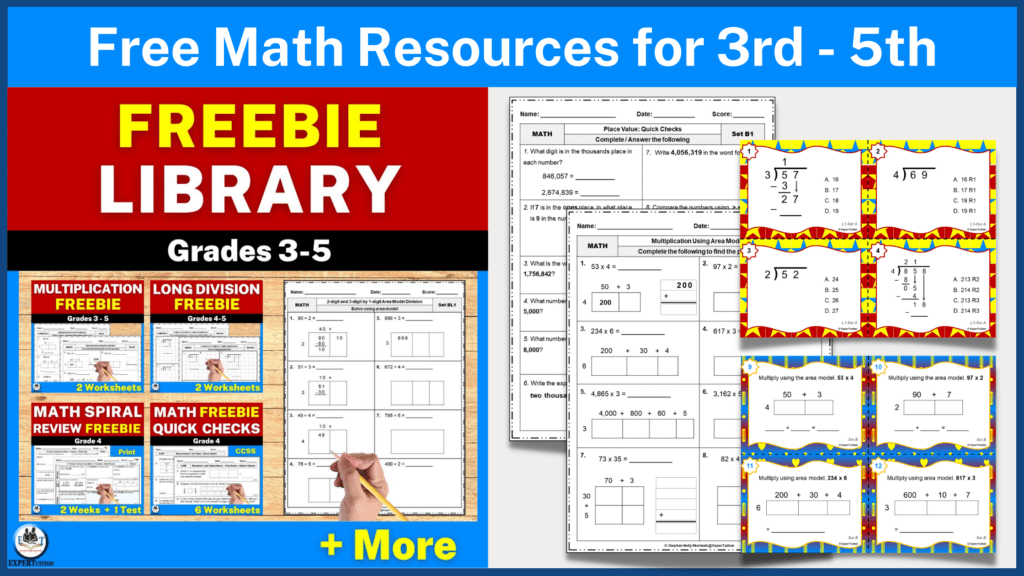
Prime and composite numbers are more than just math vocabulary terms; they’re essential tools for developing number sense, problem-solving, and critical thinking. In this post, we’ll explore how to teach prime and composite numbers effectively, with strategies, examples, and ready-to-use classroom tools to make learning engaging.
Understanding Prime and Composite Numbers
Before students can confidently identify prime and composite numbers, they need a solid understanding of factors.
- A prime number has exactly two factors: 1 and itself.
Example: 2, 3, 5, 7, 11. - A composite number has more than two factors.
Example: 4 (1, 2, 4) or 12 (1, 2, 3, 4, 6, 12).
A common misconception is that 1 is a prime number. It’s not, because it only has one factor, not two. Clarifying this early helps prevent confusion as students progress into factorization and multiples.
To help students visualize the difference, use arrays or area models. For instance, show that 7 can only make one rectangular array (1 row of 7), while 12 can make several — instantly illustrating the concept.
Why Teaching Prime and Composite Numbers Matters
Understanding prime and composite numbers builds the foundation for many advanced topics in math, including:
- Prime factorization
- Finding the Greatest Common Factor (GCF)
- Determining the Least Common Multiple (LCM)
- Simplifying fractions
When students can identify whether a number is prime or composite, they’re better equipped to see number relationships, recognize patterns, and approach multi-step problems with confidence.
Strategies for Teaching Prime and Composite Numbers
1. Start with Factors and Multiples
Before introducing primes and composites, review how to find factors.
Use factor rainbows or T-charts to list all possible factors for a number. This visual method helps students spot whether a number has only two factors or more.
2. Use Hands-On Sorting Activities
Create a Prime vs. Composite Number Sort with number cards.
Have students sort the cards based on their classification and explain their reasoning aloud. This encourages mathematical discussion and reasoning.
3. Incorporate Visual Models
Use dot arrays or counters to model numbers.
Students can quickly see that some numbers (like 7) can only form one array, while others (like 9) can form multiple arrays.
4. Encourage Pattern Discovery
Challenge students to find patterns in prime numbers using a hundred chart.
Have them color prime numbers and observe patterns — like noticing that all primes except 2 are odd.
5. Integrate Riddles and Math Talk
Ask questions like:
“I am a prime number between 10 and 20. When you add my digits together, you get 8. What am I?”
“I am a composite number between 30 and 40. I am divisible by both 3 and 4. What am I?
These riddles promote critical thinking while reinforcing the definitions of prime and composite numbers.
Engaging Activities to Reinforce Learning
Students master prime and composite numbers best through repeated, meaningful practice — and a mix of open-ended and multiple-choice questions can help solidify understanding.
Try activities such as:
- Prime Number Bingo – Have students mark primes as you call them out.
- Composite Castle Challenge – Build “castles” using blocks where each tower represents a factor.
- Prime Hunt – Give students a list of numbers and have them find all the primes in a set.
For consistent review, no-prep printable activities can be a lifesaver.
My Prime and Composite Numbers Worksheets include 12 worksheets with multiple-choice and open-ended questions for easy differentiation.
You’ll also find fun riddles, answer keys, and data trackers — so your students can practice while you save time on prep and grading.
Differentiation and Assessment
When teaching prime and composite numbers, differentiation ensures that all learners can access the concept.
- For beginners: Start with smaller numbers and visual aids like arrays or factor charts.
- For advanced learners: Introduce larger numbers and challenge them to use divisibility rules to determine if a number is prime.
- For assessment: Use quick checks, exit tickets, or digital quizzes to monitor understanding.
Open-ended questions help assess reasoning, while multiple-choice options provide quick insights into overall comprehension.
Using answer keys and data trackers, like those included in my worksheet set, can streamline grading and progress monitoring.
Final Thoughts
Teaching prime and composite numbers builds confidence and strengthens number sense — skills that support nearly every area of math learning.
With intentional instruction, visual representations, and consistent practice, students can master the art of identifying and classifying numbers with ease.
And with ready-to-use activities, you can keep lessons engaging and stress-free.
SAVE WITH THE BUNDLE (20% OFF)
-
Product on sale
 Original price was: $ 7.50.$ 6.00Current price is: $ 6.00.
Original price was: $ 7.50.$ 6.00Current price is: $ 6.00.




